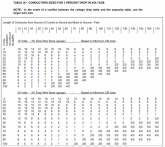but overall - like my grandmother told me -- when in doubt - go BIGGER ...
AND do whatever you can to either get UV shielded cable or put the cable in the automobile electrical cable flex hosing ... The sun is the number one killer of RV cables ...
View attachment 8548
Thank you for the chart and usable insight.
Going back and forth over technical discussion, including the AC/DC discussion, masive or stranded...
Not to mention aluminium, copper or combinations...
While alu and alu+copper have its own good benefits, 95% of "our" (forum readers and writers) are better of with pure copper.
Probably the 5% have only slight profit for ALU or alu mix.
Listen to
@ghostwriter66 grandmother.
Yes, bigger is better, and please, don't mix metal (unless soldering)
Mix metal = copper cable with aluminium lugs
It's just not worth it.
They will (in many/most cases) give you issues
You want to work cheap or safe?
I assume we all value our lives and investment made in the equipment.
Use the list provided, better go one step bigger, it never hurts and give room for extending.
Stiff bar, Flexible strands?
Like many have proven, stiff bar is "better" for DC, but really difficult to work with!
For the short distance we use (under 1000 meter) it is marginal, hardly worth any discussion.
Use the graph and advice that is provided, and your installation will be free of strange ghost.
Thanks to ghostwriter


), might make sense to use capital L for length so it can be differentiated from current.




